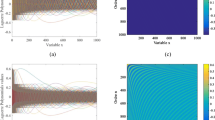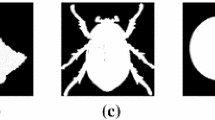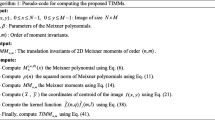Abstract
This paper is about generalized Fourier descriptors, and their application to the research of invariants under group actions. A general methodology is developed, crucially related to Pontryagin’s, Tannaka’s, Chu’s and Tatsuuma’s dualities, from abstract harmonic analysis. Application to motion groups provides a general methodology for pattern recognition. This methodology generalizes the classical basic method of Fourier-invariants of contours of objects. In the paper, we use the results of this theory, inside a Support-Vector-Machine context, for 3D objects-recognition. As usual in practice, we classify 3D objects starting from 2D information. However our method is rather general and could be applied directly to 3D data, in other contexts.
Our applications and comparisons with other methods are about human-face recognition, but also we provide tests and comparisons based upon standard data-bases such as the COIL data-base. Our methodology looks extremely efficient, and effective computations are rather simple and low cost.
The paper is divided in two parts: first, the part relative to applications and computations, in a SVM environment. The second part is devoted to the development of the general theory of generalized Fourier-descriptors, with several new results, about their completeness in particular. These results lead to simple formulas for motion-invariants of images, that are “complete” in a certain sense, and that are used in the first part of the paper. The computation of these invariants requires only standard FFT estimations, and one dimensional integration.
Similar content being viewed by others
References
Abraham, R., Robbin, J.: Transversal Mappings and Flows. Benjamin, Elmsford (1967)
Auslander, L., Tolimieri, R.: Is computing with the finite Fourier transform pure or applied mathematics? Bull. Am. Math. Soc. (N.S.) 1(6), 847–897 (1979)
Barut, A.O., Raczka, R.: Theory of Group Representations and Applications, 2nd edn. World Scientific, Singapore (1986)
Belhumeur, P., Hespanha, J., Kriegman, D.: Eigenfaces vs. fisherfaces: recognition using class specific linear projection. IEEE Trans. Pattern Anal. Mach. Intell. 19(7), 711–720 (1997)
Boser, B.E., Guyon, I.M., Vapnik, V.: A training algorithm for optimal margin classifiers. In: Proceedings orf the Fifth Annual Workshop on Computational Learning Theory, pp. 144–152. ACM, New York (1992)
Chong, C.-W., Raveendran, P., Mukundan, R.: Translation invariants of Zernike moments. Pattern Recognit. 36, 1765–1773 (2003)
Chen, S.: A new vision system and the Fourier descriptors method by group representations. In: IEEE CDC Conference, Las Vegas, USA (1985)
Chirikjian, G.S., Kyatkin, A.B.: Engineering Applications of Noncommutative Harmonic Analysis. with Emphasis on Rotation and Motion Groups. CRC Press, Boca Raton (2001)
Chang, C.-C., Lin, C.-J.: Libsvm: a library for support vector machines. Software available at http://www.csie.ntu.edu.tw/~cjlin/libsvm (2001)
Chu, H.: Compactification and duality of topological groups. Trans. Am. Math. Soc. 123, 310–324 (1966)
Dixmier, J.: Les C *-algèbres et leurs représentations. Gauthier-Villars, Paris (1969)
Fonga, H.: Analyse harmonique sur les groupes et reconnaissance de formes. PhD thesis, Université de Grenoble (1992)
Fukunaga, K.: Introduction to Statistical Pattern Recognition, 2nd edn. Academic Press, New York (1990)
Gauthier, J.P., Bornard, G., Silbermann, M.: Harmonic analysis on motion groups and their homogeneous spaces. IEEE Trans. Syst. Man Cybern. 21 (1991)
Geller, D., Kra, I., Popescu, S., Simanca, S.: On circulant matrices. Preprint, Stony Brook University
Ghorbel, F.: A complete invariant description for grey level images by the harmonic analysis approach. Pattern Recognit. Lett. 15 (1994)
Gourd, F.: Quelques méthodes d’analyse harmonique en théorie de la détection et de la reconnaissance de formes. PhD thesis, Université de Grenoble (1990)
Gourd, F., Gauthier, J.P., Younes, H.: Une méthode d’invariants de l’analyse harmonique en reconnaissance de formes. Traitement Signal 6(3) (1989)
Guo, G.-D., Li, S., Chan, K.: Face recognition by support vector machines. In: Proceedings of International Conference on Automatic Face and Gesture Recognition, pp. 196–201 (2000)
Hewitt, E., Ross, K.A.: Abstract Harmonic Analysis. Springer, Berlin (1963)
Heyer, H.: Dualität über Lokal Kompakter Gruppen. Springer, Berlin (1970)
Hjelmas, E.: Face detection: a survey. Comput. Vis. Image Underst. 83, 236–274 (2001)
Huang, R., Pavlovic, V., Metxas, D.N.: A hybrid face recognition method using Markov random fields. In: Proceedings of ICPR, pp. 157–160 (2004)
Joyal, A., Street, R.: An introduction to Tannaka duality and quantum groups. In: Lecture Notes in Mathematics, vol. 1488, pp. 411–492. Springer, Berlin (1991)
Kadir, T., Zisserman, A., Brady, M.: An affine invariant salient region detector. In: ECCV, pp. 404–416 (2004)
Kanatani, K.: Group Theoretical Methods in Image Understanding. Springer, Berlin (1990)
Kanatani, K., Chou, T.: Shape from texture: general principle. Artif. Intell. 38(1), 1–48 (1989)
Khotanzad, A., Yaw, H.H.: Invariant image recognition by Zernike moments. IEEE Trans. Pattern Anal. Mach. Intell. 12(5), 489–497 (1990)
Kyatkin, A.B., Chirikjian, G.S.: Pattern matching as a correlation on the discrete motion group. Comput. Vis. Image Underst. 74(1), 22–35 (1999)
Kyatkin, A.B., Chirikjian, G.S.: Algorithms for fast convolution on motion groups. Appl. Comput. Harmon. Anal. 9, 220–241 (2000)
Lawrence, S., Giles, C.L., Tsoi, A.C., Back, A.D.: Face recognition: a convolutional neural network approach. IEEE Trans. Neural Netw. 8, 98–113 (1997)
Leduc, J.P.: A group-theoretic construction with spatiotemporal wavelets for the analysis of rotational motion. J. Math. Imaging Vis. 17(3), 207–236 (2002)
Lowe, D.: Distinctive image features from scale invariant keypoints. Int. J. Comput. Vis. 60(2), 91–110 (2004)
Martinez, A.M.: Recognition of partially occluded and/or imprecisely localized faces using probabilistic approach. In: Proceedings of IEEE Computer Vision and Pattern Recognition, CVPR’2000, pp. 712–717 (2000)
Matas, J., Chum, O., Urban, M., Pajdla, T.: Robust wide baseline stereo from maximally stable extremal regions. In: BMVC, pp. 384–393 (2002)
Mikolajczyk, K., Schmid, C.: Scale and affine invariant interest point detectors. Int. J. Comput. Vis. 60(1), 63–86 (2004)
Mukundan, R., Ramakrishnan, K.R.: Moment Functions in Image Analysis-Theory and Applications. World Scientific, Singapore (1998)
Mukundan, R., Ramakrishnan, K.R.: Fast computation of Legendre and Zernike moments. Pattern Recognit. 28(9), 1433–1442 (1995)
Murase, H., Nayar, S.K.: Visual learning and recognition of 3D objects from appearance. Int. J. Comput. Vis. 14(1), 5–24 (1995)
Murenzi, R.: Wavelet transform associated to the n-dimensional Euclidean group with dilations: signals in more than one dimension. In: Combes, J.M., Grossmann, A., Tchamitchian, P. (eds.) Wavelets: Time-Frequency Methods in Phase Space, pp. 239–246 (1990)
Obrzalek, S., Matas, J.: Object recognition using local affine frames on distinguished regions. In: Electronic Proceeding of the 13th British Machine Vision Conference, University of Cardiff, pp. 113–122 (2002)
ORL face database, AT&T Laboratories, Cambridge, U.K. http://www.cam-orl.co.uk/facedatabase.html
Persoon, O., King, S.F.: Shape discrimination using Fourier descriptors, IEEE Syst. Man Cybern. 7(3) (1977)
Rockmore, D.N.: Recent progress and applications in group FFTs. In: Computational noncommutative algebra and applications. NATO Sci. Ser. II Math. Phys. Chem., vol. 136, pp. 227–254. Kluwer Academic, Dordrecht (2004)
Samaria, F.S., Harter, A.C.: Parametrization of a stochastic model for human face identification. In: Proceedings of the 2nd IEEE Workshop on Applications of Computer Vision (1994)
Segman, J., Zeevi, Y.: Image analysis by wavelet type transforms: group theoretical approach. J. Math. Imaging Vis. 3, 51–77 (1993)
Tatsuuma, N.: A duality theorem for locally compact groups. J. Math. Kyoto Univ. 6, 187–293 (1967)
Tuytelaars, T., Van Gool, L.: Matching widely separated views based on affine invariant regions. Int. J. Comput. Vis. 59(1), 61–85 (2004)
Turk, M., Pentland, A.: Eigenfaces for recognition. J. Cogn. Neurosci. 3(1), 71–86 (1991)
Turski, J.: Geometric Fourier analysis of the conformal camera for active vision. SIAM Rev. 46(1) (2004)
Vapnik, V.N.: The Statistical Learning Theory. Springer, Berlin (1998)
Vapnik, V.N., Chervonenkis, A.J.: On the uniform convergences of relative frequencies of events to their probabilities. Theory Probab. Appl. 16, 264–280 (1971)
Vilenkin, N.: Fonctions spéciales et théorie de la représentation des groupes. Dunod, Paris (1969)
Warner, G.: Harmonic Analysis on Semi-Simple Lie Groups. Springer, Berlin (1972)
Weil, A.: L’intégration dans les groupes topologiques et ses applications. Hermann, Paris (1965)
Author information
Authors and Affiliations
Corresponding author
Rights and permissions
About this article
Cite this article
Smach, F., Lemaître, C., Gauthier, JP. et al. Generalized Fourier Descriptors with Applications to Objects Recognition in SVM Context. J Math Imaging Vis 30, 43–71 (2008). https://doi.org/10.1007/s10851-007-0036-3
Received:
Accepted:
Published:
Issue Date:
DOI: https://doi.org/10.1007/s10851-007-0036-3




